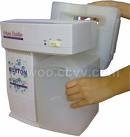Water Distillers
You may have already bought distilled water from time to time at the grocery store to use in your iron or steam cleaning devices. The difference between distilled water and your standard tap water is the distilled water has all of the minerals removed from it.
Not the Best for Drinking
As far as drinking water goes, studies have shown that distilled water is not the best for you. Not only does it not have any minerals in it but research has shown that it may in fact work to extract minerals from the foods that you eat.
No Mineral Deposits
However; water distillation equipment does have many industrial and household uses. For instance, if you put water in your cars radiator and it is a brass radiator, using water distillers will help in preventing deposits from building up in your cars radiator.
Singing in the Rain
Also many people claim that they get better results from distilled water when they wash and rinse their hair with it. The soap gets foamier and the rinse tends to be more complete, resulting in cleaner feeling hair when the entire process is complete.
No Mineral Spots
The same goes for rinsing your car. By rinsing with distilled water, you are virtually assured that there will be no white mineral spots on the car when the job is done. The same goes for any other type of commercial cleaning job.
Industrial uses for Water Distillation Equipment
Industries of all types rely heavily water distillation equipment. One typical example would be in metal plating, when absolute purity of the plating solution is must. Also, there are countless other types of commercial and industrial processes where water is boiled off and untreated water would leave problematic deposits.
source: http://www.articlesbase.com/home-business-articles/the-many-uses-for-water-distillation-equipment-667147.html
water distillers
You may have already bought distilled water from time to time at the grocery store to use in your iron or steam cleaning devices. The difference between distilled water and your standard tap water is the distilled water has all of the minerals removed from it.
Not the Best for Drinking
As far as drinking water goes, studies have shown that distilled water is not the best for you. Not only does it not have any minerals in it but research has shown that it may in fact work to extract minerals from the foods that you eat.
No Mineral Deposits
However; water distillation equipment does have many industrial and household uses. For instance, if you put water in your cars radiator and it is a brass radiator, using water distillers will help in preventing deposits from building up in your cars radiator.
Singing in the Rain
Also many people claim that they get better results from distilled water when they wash and rinse their hair with it. The soap gets foamier and the rinse tends to be more complete, resulting in cleaner feeling hair when the entire process is complete.
No Mineral Spots
The same goes for rinsing your car. By rinsing with distilled water, you are virtually assured that there will be no white mineral spots on the car when the job is done. The same goes for any other type of commercial cleaning job.
Industrial uses for Water Distillation Equipment
Industries of all types rely heavily water distillation equipment. One typical example would be in metal plating, when absolute purity of the plating solution is must. Also, there are countless other types of commercial and industrial processes where water is boiled off and untreated water would leave problematic deposits.
source: http://www.articlesbase.com/home-business-articles/the-many-uses-for-water-distillation-equipment-667147.html
water distillers





